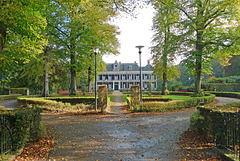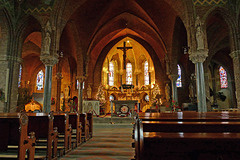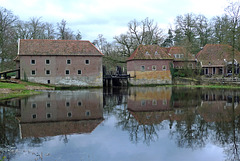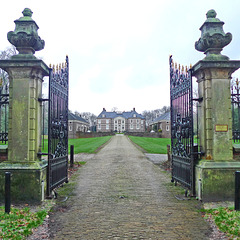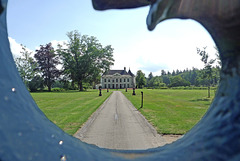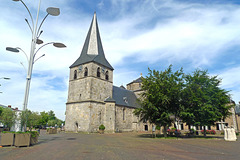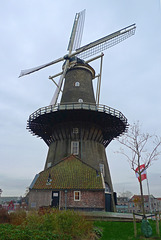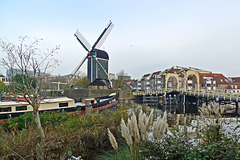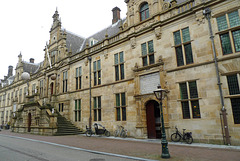Jaap van 't Veen's photos
Nederland - Huis te Echten
| |
|
|
|
Huis te Echten (Echten Manor) is a so called havezate (fortified house, homestead, court or farm of a nobelman). As early as the 13th century, there is mentioned a hofstat (homestead, large house with land) belonging to Volker van Echten, a descendant of the viscounts of Coevorden. It is not certain whether this hofstat was the later Huis te Echten . Parts of the current house probably date from the 15th century.
A moat around the building dates from before 1700. The house was probably converted into a house around a courtyard with two wings in the early 18th century. Due to a later renovation in 1808, many older building elements disappeared. Later, parts of the building were added on the north and south sides.
Huis te Echten was inhabited until 1971 by the families Van Echten and Van Holthe tot Echten. After the death of the last Mr Van Echten, his daughter Anna Geertruida married Rudolph Otto van Holthe in 1802, who started calling himself Van Holthe tot Echten. Their descendants continued to inhabit the manor.
The house was restored from 1976 to 1981. From 1975 to 2023, Stichting Visio - a foundation for visually and mentally handicapped people, was housed in Huis te Echten .
Nederland - Denekamp, Sint-Nicolaaskerk
| |
|
|
|
The history of the Sint-Nicolaaskerk (Church of Saint Nicholas) is dating back to the year of 1276, when Denekamp was mentioned as a parish for the first time. The church is one of the few religious buildings erected in the region of Twente in the 13th century that is still largely preserved.
The medieval part of the present church consists of a single-bay. As far as this region of the Netherlands is concerned it is the oldest preserved single-bay church, though no longer completely intact.
The medieval parts were built of sandstone from nearby Bentheim. The tower was built against the church in the second half of the 15th century (or early 16th century). Later there were many more enlargements, the last one started in 1910 with the construction of a new transept and choir and apse, which were built with bricks. Architect ‘Te Riele’ also gave the tower - which had been fully closed - an entrance in a pseudo-Romanesque style.
After the reformation the church was used by the protestant minority for about two centuries. In 1809 King ‘Lodewijk Napoleon’ gave back the church to the Catholics. The church is still used for services.
Nederland - Denekamp, Watermolen Singraven
| |
|
|
|
Singraven is an estate near the town of Denekamp. It includes a manor, a garden, a water mill, a carriage house and a number of farmhouses. The estate offers a versatile landscape with forests, lanes, fields, meadows, marshes and the ever-present river Dinkel.
The water mill has been part of Landgoed Singraven (Singraven Estate) since 1448. The mill consists of an oil mill (no longer in operation and partly demolished, nowadays housing a restaurant), a corn mill and a saw mill. The corn mill and saw mill are still in operation and can be visited. The mill is run - mostly on Saturdays during summer time - by volunteer millers.
Watermolen Singraven is the last water-driven undershot sawmill in the Netherlands. Its water supply comes from the small river Dinkel, which rises in the town of Holtwyck in Nordrein Westfalen (Germany).
The mill has three water wheels, each with a diameter of 5.5 metres. The left wheel against the restaurant is from the former oil mill. The oil mill was demolished in the early 20th century, so the wheel is the only remaining part. The middle wheel is from the corn mill and the right wheel from the sawmill.
Nederland - Denekamp, Huis Singraven
| |
|
|
|
Singraven is an estate near the town of Denekamp. It includes a manor, a garden, a water mill (dating back to1448), a carriage house (1868) and a number of farmhouses. The estate offers a versatile landscape with forests, lanes, fields, meadows, marshes and the ever-present river Dinkel.
Huis Singraven (Singraven Manor) has a rich history. In 1381, the estate is first mentioned as an agricultural farmstead Hof ten Singraven ; property of the bishop of Utrecht. In 1398 the house came into the possession of a family who fortified it into a manor in 1415. After being owned by several families, the estate eventually came into the possession of Willem Frederik Jan Laan. This private owner was the last resident of Huis Singraven .
Mr Laan commissioned several substantial renovations and restorations, including a neo-classical façade. During the period he lived in the house, he amassed a huge art and antiques collection. Mr Laan gave ownership of the estate to the “Edwina van Heek Foundation” in 1956 under the condition that everything should continue to exist in its original state.
Huis Singraven has limited opening hours and can only be visited by a guided tour.
Nederland - Huis Almelo
| |
|
|
|
Huis Almelo (Manor Almelo) is first mentioned in the 13th century when Egbert of Almelo left in his will the legacy of his castle in Almelo on 6th June 1297. What the house looked like at the time is unknown. Later, around 1652, the original house was demolished and replaced with a new building by Zeger van Rechteren. By the end of that year the new brick-built house was ready for habitation.
Unfortunately all this beauty was to be short-lived due to the occupation of the troops of tishops Troops from Munster 1665-1666, when they inavded the Netherlands. This occupation led to considerable damage being caused to the home and after the troops departed, the slow job of restoring this once impressive home to its former glory. Commissioned by count Adolf Frederik the restoration work began and between 1883 and 1885 the house was fully restored and renewed.
To this day, Huis Almelo remains in the hands of the Van Rechteren Limpurg family. Being still inhabited it is not possible to vsit the manor and one has to be satisfied with looking at the manor from the entrance gate.
Nederland - Denekamp, Huis Singraven
| |
|
|
|
hFF: the main picture was taken through a fence, which is the frame of the image
Singraven is an estate near the town of Denekamp. It includes a manor, a garden, a water mill (dating back to1448), a carriage house (1868) and a number of farmhouses. The estate offers a versatile landscape with forests, lanes, fields, meadows, marshes and the ever-present river Dinkel.
Huis Singraven (Singraven Manor) has a rich history. In 1381, the estate is first mentioned as an agricultural farmstead Hof ten Singraven ; property of the bishop of Utrecht. In 1398 the house came into the possession of a family who fortified it into a manor in 1415. After being owned by several families, the estate eventually came into the possession of Willem Frederik Jan Laan. This private owner was the last resident of Huis Singraven .
Mr Laan commissioned several substantial renovations and restorations, including a neo-classical façade. During the period he lived in the house, he amassed a huge art and antiques collection. Mr Laan gave ownership of the estate to the “Edwina van Heek Foundation” in 1956 under the condition that everything should continue to exist in its original state.
Nederland - Haarzuilens, Kasteel de Haar
| |
|
|
|
Kasteel de Haar (The Haar Castle) is one of the most visited castles in the Netherlands. Originally it was named Het Huys te Haer . However the current Gothic fairy-tale castle was built between 1892 and 1912 with incorporation of the large 15th century ruins of the original castle.
Kasteel de Haar was first mentioned in 1391 along a blind arm of the river Rhine. Originally the owner was a member of the “Van de Haar” family. In 1449 the castle became property of the “Van Zuylen” family through the marriage between Josyna van de Haar and Dirk van Zuylen. Several families owned the castle until 1890 when baron “Etienne van Zuylen van Nijevelt”, inherited Kasteel de Haar (by then the castle had been in a ruinous and desolate state for almost two centuries). In 1887 Etienne had married the French baroness Helene de Rothschild (member of the extremely wealthy De Rothschild family), which enabled him to rebuilt the castle.
In 1892 the rebuilding of Kasteel de Haar started under the direction of the well known Dutch architect Cuypers. It's his interpretation of the ‘medieval’ castle one can see today. The interior was rebuilt in an un-Dutch luxurious style, it was equipped with electricity and the former courtyard, covered with a large roof, was turned into an imprerssive central hall. The interior is luxuriously decorated with a large but incoherent collection of valuable antiques from all over the world.
In 2000 the ownership of the castle was transferred to “Stichting Kasteel de Haar”. This foundation worked to transform the place into a museum and event center. The castle has 200 rooms - although not all of them can be visited. A couple of rooms are arranged with realistic displays to show how the castle would have looked like in his days of parties. Nowadays Kasteel de Haar is (almost) open daily for visitors.
Nederland - Denekamp, Sint-Nicolaaskerk
| |
|
|
|
The history of the Sint-Nicolaaskerk (Church of Saint Nicholas) is dating back to the year of 1276, when Denekamp was mentioned as a parish for the first time. The church is one of the few religious buildings erected in the region of Twente in the 13th century that is still largely preserved.
The medieval part of the present church consists of a single-bay. As far as this region of the Netherlands is concerned it is the oldest preserved single-bay church, though no longer completely intact.
The medieval parts were built of sandstone from nearby Bentheim. The tower was built against the church in the second half of the 15th century (or early 16th century). Later there were many more enlargements, the last one started in 1910 with the construction of a new transept and choir and apse, which were built with bricks. Architect ‘Te Riele’ also gave the tower - which had been fully closed - an entrance in a pseudo-Romanesque style.
After the reformation the church was used by the protestant minority for about two centuries. In 1809 King ‘Lodewijk Napoleon’ gave back the church to the Catholics. The church is still used for services.
Nederland - Denekamp, Watermolen Singraven
| |
|
|
|
Singraven is an estate near the town of Denekamp. It includes a manor, a garden, a water mill, a carriage house and a number of farmhouses. The estate offers a versatile landscape with forests, lanes, fields, meadows, marshes and the ever-present river Dinkel.
The water mill has been part of Landgoed Singraven (Singraven Estate) since 1448. The mill consists of an oil mill (no longer in operation and partly demolished, nowadays housing a restaurant), a corn mill and a saw mill. The corn mill and saw mill are still in operation and can be visited. The mill is run - mostly on Saturdays during summer time - by volunteer millers.
Watermolen Singraven is the last water-driven undershot sawmill in the Netherlands. Its water supply comes from the small river Dinkel, which rises in the town of Holtwyck in Nordrein Westfalen (Germany).
The mill has three water wheels, each with a diameter of 5.5 metres. The left wheel against the restaurant is from the former oil mill. The oil mill was demolished in the early 20th century, so the wheel is the only remaining part. The middle wheel is from the corn mill and the right wheel from the sawmill.
Nederland - Leiden, Lakenhal
| |
|
|
|
In 1638 the city council of Leiden decided to build an inspection hall for woollen cloth: the Laecken-Halle (nowadays named Lakenhal ). Architect Arent van 's-Gravesande was commissioned to design a classicist city hall. The hall should reflect the quality and international reputation of the fabrics that made Leiden so rich in the 17th century. Three years later was the official opening of the Laecken-Halle .
For centuries it served as an inspection hall for woolen cloth fabrics that were exported from Leiden all over the world. The original front of the building is still completely intact, but a lot has changed on the inside over time.
Due to the decline of the textile industry, the Laecken-Halle lost its function as hall of inspection for cloth and in 1820 it was taken into use as the Hall of Manufactures and cholera hospital.
Since 1874 it houses Museum De Lakenhal : the municipality museum of Leiden, exhibiting arts, crafts and history of Leiden.
Nederland - Leiden, De Valk
| |
|
|
|
Windmill De Valk (The Falcon) is the third mill built at this location. In 1611 a postmill was built, which was replaced in 1667 by a wooden post mill. The current tower mill is dating back to the year of 1743.
The new, stone flour mill had to accommodate two families and had to be high enough - it is one of the tallest windmills in the country - to rise above the houses in its surroundings in order to catch enough wind. The ground floor and the additional building contained the kitchens, living areas and stable of the two houses. The sleeping rooms where located on the first and second floor, while the third served as storage room. The milling activities took place in the spaces located from the fourth floor (14 meters) to the top of the mill (29 meters).
After the death of the last miller, the mill became a museum in 1966. Nowadays
De Valk houses a museum offering an overview of its history, as well as the function of windmills in the Netherlands. It also has the only original miller’s house in the Netherlands.
Nederland - Leiden, De Put
| |
|
|
|
Windmill De Put is named after miller Jan Jansz. Put, owner of the mill that was located on this spot in the 17th century. The original mill dates from 1619, and burned down in 1640. After the wooden flour mill was rebuilt afterwards, it had to make way in 1729 for a stone tower mill. This mill was demolished in 1817.
Archaeologists discovered the foundations of the octagonal mill in 1982. The idea was put forward to build a post mill on the old bastion. This idea was finally realized five years later and in 1987 the cormill was rebuild on the former ramparts of the city of Leiden.
De Put is located nearby the Rembrandtbrug and Rembrandtplein . It is believed that the original mill once was operated by the father of the famous Dutch painter Rembrandt van Rijn, who was born nearby the windmill.
Normally the mill is open on Saturdays and is still functioning.
Nederland - Leiden, stadhuis
| |
|
|
|
Leiden town hall is located on the Breestraat as early as the Middle Ages. In 1595/96 it was given a new facade in Renaissance style. The city government wanted to show the city's new prosperity. In 1574 Leiden had been besieged by the Spanish. Many citizens died of hunger and plague. Nonetheless Leiden withstood the siege. The city was relieved on 3 October 1574. Several parts of the town hall facade commemorate this Siege and Relief of Leiden.
The town hall was largely lost during a devastating fire in 1929. The façade was rebuilt, but the building behind was completely rebuilt in 1932. Nowadays, Leiden town hal is mainly used as a wedding venue. However, city councillors still regularly reside in Leiden town hall.
Nederland - Leiden, Morspoort
| |
|
|
|
The Morspoort was built in 1669 as Leiden expanded to the west. This gate replaced a wooden gate from 1611. The stone gate was built in a Dutch Renaissance style common for the time. It is one of the eight original city gates the city once had. The other gates were demolished in the 19th century.
The gate with its octagonal dome was a prison for a long time. Next to the gate was a field where the executed were hanged.
The gate was named after the marshy area - The Morsch - on the outskirts of Leiden. The Morspoort and the nearby bridge are a Dutch National Monument.
Nederland - Leiden, Pieterskerk
| |
|
|
|
The Pieterskerk - the oldest parish church of Leiden - is a late Gothic church. In 1121 the church was consecrated a court chapel for the Counts of Holland. The building was dedicated to the apostle Peter
The current church took approximately 180 years to build, starting in 1390.
The church was a catholic church, but during the so called beeldenstorm (attack on the images or statues) in the year of 1566 Calvinists attacked the church to destroy Catholic choir books, statues, and an altarpiece. Shortly after, the church was closed prior to being converted into a Protestant church. The original windows were destroyed in a gunpowder explosion in 1807. The windows were boarded up, and it wasn't until 1880 that a large-scale restoration took place.
The Pieterskerk used to have a tower, eventually reaching 110 meters (including the 35-meter-tall wooden spire). It collapsed in 1512, but the tower was not restored and the church remains towerless.
Before 1811 many prominent people were buried in the Pieterskerk, such as the Dutch theologian Jacobus Arminius, scientist Herman Boerhaave, painter Jan Steen, John Robinson, pastor of the "Pilgrim Fathers" and Rembrandt’s parents.
The church was deconsecrated in 1971 and since 1975 has been managed by a foundation and is used for a wide range of events. It is also a ‘kind of a nuseum’ and can be visited for a small fee.
(To be honest, we were not very impressed by the interior. The huge hall makes a rather empty impression and there is not very much to see. Add to that the choir was full of furniture from the café next door. Then again, the beautiful Church Trustees Room - of which we saw a picture in the church - cannot be visited. All in all: rather disappointing)
Nederland - Warmond, Huys te Warmont
| |
|
|
|
Huys te Warmont (Warmont House) is a medieval fortified farmhouse, which originally was built in the 14th century, but destroyed by Spanish troops in 1573 during the Eighty Years' War. Around 1600, the castle was rebuilt and surrounded by orchards, meadows and gardens.
For a long time, this ‘castle’ was the seat of the lords and ladies of Warmond. From here they ruled the village. Warmond was a high lordship, which meant that the lords and ladies of Warmond could rule in their own territory more or less as independent princes.
Huys te Warmont was the home of the lords of Warmond. Although it dates from the Middle Ages, in its present form it is a late 18th century manor house. The Van den Woude family inhabited the house from about 1300 to 1525. In the 16th century, the house passed to the Van Duvenvoorde family, who later called themselves “Van Wassenaar”.
The house is currently privately inhabited and is not open to the public. The park- with beautiful old trees - surrounding the house is a nice walking area and is free to enter.
Nederland - Oegstgeest, Kasteel Oud-Poelgeest
| |
|
|
|
The country estate Oud-Poelgeest (officially Kasteel Oud-Poelgeest) was built in 1668 in the Dutch Neoclassical style on the foundations of the medieval castle Alkemade. This castle was destroyed by Spanish troops in 1574.
The well-known humanist and physician Herman Boerhaave lived here between 1724 and 1738. He grew plants at Oud-Poelgeest for which there was no room in the botanical garden of Leiden University.
In the 19th century, four towers were built on the square house - making it look more like a castle - along with the coach house. The grounds also contain a gardener's house, a neo-Gothic chapel and a well dating from 1550. These building and the surrounding park are protected as a Dutch national monument.
Today, the coach house is a hotel-restaurant. The castle is used as a conference centre
Nederland - Nunhem, Leumolen
| |
|
|
|
October 2023 marked the 250th anniversary of the “Leumolen” (Leu Mill); counting from the time of its rebuilding in 1773. The mill is also known as St. Ursula's Mill.
There had been a mill at this location on the Leubeek for much longer. In 1461, a will first mentioned the “Leumolen” under the name “Molen aan de Leu”. It is possible that the mill had existed even much longer, with a charter mentioning a mill in Nunhem as early as the 13th century. The water mill from 1461 no longer exists; the loam mill was rebuilt in brick in the period 1771-1775. An oil mill was added to the existing grain mill. The mill house was completed in 1773, and the oil mill in 1775.
A major change to the mill took place in 1911 when the water wheel was replaced by a turbine. In 1956, “Staatsbosbeheer” - a Dutch government organisation for forestry and management of nature reserves - bought the water mill. During a restoration in 1960-1961, the water wheel returned.
After this restoration, only the grain mill was still in operation, but in 2008 the oil mill was also restored. The “Leumolen” is one of six water-powered oil mills in the Netherlands and the only one to house a flour mill and an oil mill under one roof.
Jump to top
- ipernity © 2007-2024
- Help & Contact
|
Club news
|
About ipernity
|
History |
ipernity Club & Prices |
Guide of good conduct
Donate | Group guidelines | Privacy policy | Terms of use | Statutes | In memoria -
Facebook
Twitter

